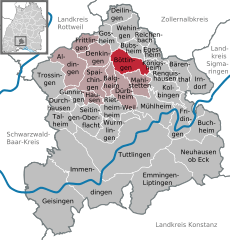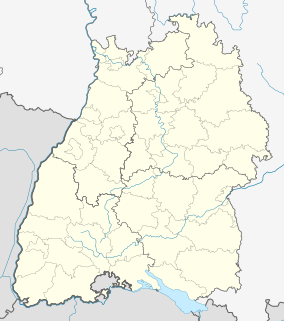Böttingen
Böttingen is a municipality in the district of Tuttlingen in Baden-Württemberg in Germany. In recent decades it has developed from an agricultural village to an advanced industrial community.
Böttingen | |
|---|---|
 Coat of arms | |
Location of Böttingen within Tuttlingen district   | |
 Böttingen  Böttingen | |
| Coordinates: 48°06′02″N 08°48′17″E | |
| Country | Germany |
| State | Baden-Württemberg |
| Admin. region | Freiburg |
| District | Tuttlingen |
| Government | |
| • Mayor | Gerhard Minder (CDU) |
| Area | |
| • Total | 16.31 km2 (6.30 sq mi) |
| Elevation | 915 m (3,002 ft) |
| Population (2018-12-31)[1] | |
| • Total | 1,422 |
| • Density | 87/km2 (230/sq mi) |
| Time zone | CET/CEST (UTC+1/+2) |
| Postal codes | 78583 |
| Dialling codes | 07429 |
| Vehicle registration | TUT |
| Website | www.boettingen.de |
Geography
Böttingen sits on a plateau in the southwestern Swabian Jura in a long dry valley. At an elevation of 911 to 991 meters it was the highest village in the historical Kingdom of Württemberg.
The municipality borders Gosheim to the north, Bubsheim to the northeast, Königsheim to the east, Mahlstetten and Dürbheim to the south, and Balgheim and Denkingen to the West.
The municipality Böttingen consists of the village Böttingen and the Gehöft Allenspacher manor, as well as the abandoned villages Leineburg and Windingen.
History
The first written mention of Böttingen was in 802 and contained a land title grant by the Abbey of Saint Gall. Celtic and Alemanni grave finds as well as flint axes in a cave indicate an earlier Stone Age settlement. After 1253 the territory paid tribute and received protection from the Beuron Archabbey, after a change of ownership the Bishopric of Constance, and then the Herren von Enzberg, until it became part of Württemberg in 1805. The village had to pay interest and tithe as well as socage until 1848.
The Überbündische meeting (in short "ÜT") took place 1977 and 2017 in Allenspach courtyard of the evangelical church youth, Jungenschaft Horte. A total of 3.400 people took part in at least 45 different societies and institutions of scouts and youth movement. [2] [3]
Politics
The community belongs to the Amt Spaichingen.
Sights
- The Alter Berg mountain landmark (980 meters above sea level) with a chapel on the summit has a view over the preserved natural landscape of the southwest Swabian Alb. In ideal weather conditions the panorama view includes the Alps. A metal sheet in front of the chapel displays the names of many of the surrounding summits.
- 60 km-long cross-country skiing trail network on the plateau
- Posted hiking trails in multiple directions, in parts within the Donauberglandweg hiking trail network, leading e.g. into the picturesque Danube river valley.
Notable residents
- Bernard Häring, Catholic theologian
- Margret Marquart, theologian and missionary doctor in Uganda and Ghana (died 2004)[4]
References
- "Bevölkerung nach Nationalität und Geschlecht am 31. Dezember 2018". Statistisches Landesamt Baden-Württemberg (in German). July 2019.
- ÜT meeting 1977 Böttingen
- ÜT meeting 2017 Böttingen
- Marquart